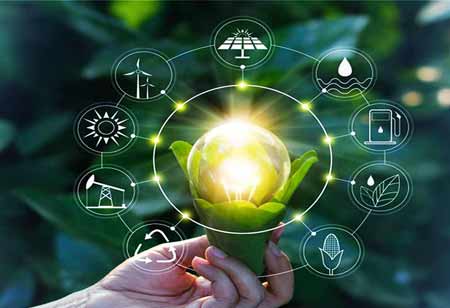Thank you for Subscribing to Energy Business Review Weekly Brief
Blockchain Technology: On a Journey to Revamp the Future of Transactions
Applications based on blockchain are widely used across almost all industry sectors.

By
Energy Business Review | Saturday, March 18, 2023
Stay ahead of the industry with exclusive feature stories on the top companies, expert insights and the latest news delivered straight to your inbox. Subscribe today.
Currently, one of the most well-liked technological trends worldwide is blockchain. Many enterprises and domains have already started using blockchain technology thanks to qualities like immutability and decentralisation.
FREMONT, CA: Applications based on blockchain are widely used across almost all industry sectors. Businesses across a wide range of industry sectors can be observed embracing blockchain technology for digital transformation. Recording, retrieving, and settling transactions of any kind are one of the most advantageous uses of blockchain.
Recording transactions is a necessary yet time-consuming operation for any organisation. It is frequently done by personnel using Excel spreadsheets, which makes it quite error-prone. The system can become completely unresponsive from a single record error, which can have far-reaching effects. The consensus algorithm and encryption capabilities of blockchain technology can reduce human error. A blockchain's chronological linking of all blocks makes it possible to identify the beginning of an incorrect transaction. The system is substantially more dependable and error-free.
The use of blockchain technology is widespread across many different services and sectors. For instance, as retail investors, individuals can use exchange-traded funds to utilise blockchain as a portfolio diversification tool (ETFs). Cryptocurrencies can be an excellent addition to the investment strategy. Besides that, NFTs may be a source of revenue for businesses looking to invest in marketplace development.
Having established that, another advantage of blockchain technology is the simplicity, speed, and value that blockchain technology offers to a variety of industries as part of the expanding economy. Due to all these benefits, blockchain technology is positioned to significantly change how transactions are conducted in the future.
Fundamentals of Blockchain Technology
To comprehend the impact that blockchain technology will have on how transactions are conducted in the future, it is important to understand some of the fundamental concepts behind this revolutionary technology.
Multiple Connected Blockchains
The idea that there is a single blockchain to which all transactions are added is a prevalent misconception. That is untrue. The system contains several blockchains. Things may coexist separately or be interconnected. In this regard, the blockchain ecosystem is similar to the internet. Blockchains are not linked to a central server or hub, which is a key distinction between them and the internet. Similar to a server, each node in a blockchain stores copies of the distributed ledger of that blockchain.
Consensus and Reward System
A consensus and rewarding mechanism is implemented to keep a blockchain's functioning and integrity intact. When a transaction first appears on a blockchain, all miners in the chain begin verifying it by utilising extremely powerful computers to solve challenging mathematical puzzles. Once a miner has figured out a puzzle, other miners confirm his solution. The transaction and its resolution are bundled into a block and posted to the blockchain once they attain a consensus.
Inflexible and Encrypted
Blockchains contain an append-only method. Once added to a blockchain, data cannot be changed. A change in one transaction in one block will affect all associated blocks and notify all blockchain nodes because all blocks are interconnected. Blockchains are viewed as being very secure as a result. The encryption system is another security element. The data within is in encrypted form even though a blockchain is open-source and visible to all. Without the proper credentials of a legitimate miner, it is practically impossible to decipher it. As a result, blockchains are more resistant to hack assaults than traditional media.
Open Source and Distributed
Blocks of transactions are connected in chronological order to form blockchains. Every blockchain node has a copy of the ledger. A blockchain is accessible to everyone, but adding a transaction will require the agreement of all system miners.
How Blockchain Technology Will Impact Transactions
1. Efficiency in Settlements
Traditionally, the settlement of deals takes days or weeks. For instance, it may take months to register the ownership of a two-wheeler after it is purchased. Instantaneous settlements are one of the main benefits of blockchain technology. Processing delays are kept to a minimum and human involvement is eliminated because there are no middlemen and all verification is logic-based.
2. Elimination of Intermediaries
Third-party intermediaries are not used in blockchain transactions. These are checked by miners who work nonstop to solve mathematical puzzles. The transaction is confirmed and posted to the distributed ledger as soon as these calculations are finished. The blockchain reflects the modification. There is no need for extensive paperwork or expensive verification fees. Because the reward for miners is so little, it has no impact on the other parties to the transaction. The process is sped up and transaction costs are decreased when intermediaries are eliminated.
3. Increased Transparency and Security of Data
By utilising blockchain technology, businesses' and organisations' data storage practices will significantly change. Record-keeping is currently a time-consuming activity that costs a lot of money and requires a committed workforce. It is also vulnerable to human error and natural disasters like fires and theft. Blockchains are digital distributed ledgers that do not have any of these drawbacks. The storage of transactions is organised, unchangeable, and encrypted. All nodes can access them, but they cannot be changed.






